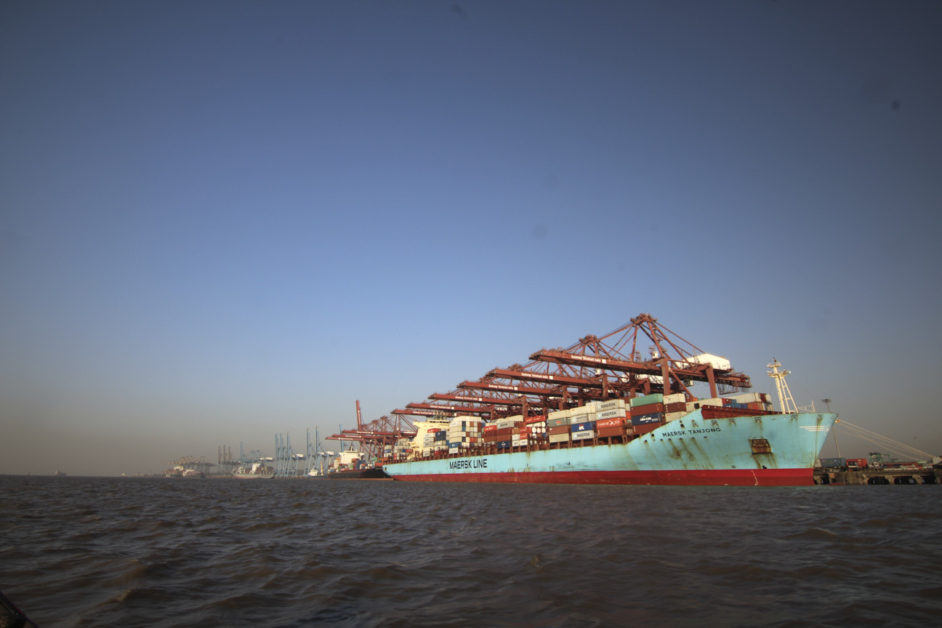The huge traffic is generated from ad hoc and additional vessel calls at the terminal operating in India’s second busiest container port.
The restrictions imposed by the local traffic police has added to the woes.
By turns, some of the terminals at J N Port have faced congestion recently with vessels calling out of their scheduled service window or making ad hoc or additional calls as the almost yearlong Red Sea crisis and tensions in the Middle East force ships to take a longer detour via the Cape of Good Hope, avoiding the shorter Suez Canal route.
The latest to be hit by the rising tide of container arrivals is Gateway Terminals India Pvt Ltd (GTI), 74 percent owned by A P M Terminals Management B V, the container terminal operating unit of A P Moller- Maersk A/S. GTI, one of the five container terminals operating at J N Port, has been getting most of the ad hoc vessels calls.
Whichever terminal gets ad hoc vessels that come under stress, says trade sources.
“Heavy congestion at GTI continues to persist for the last 13 days, with no respite whatsoever,” says Umesh Grover, Secretary General at the Container Freight Stations Association of India (CFSAI), an industry group.
“There has been no congestion on the seaside. While major container ports globally are choked, Jawaharlal Nehru Port Authority has managed the situation well. However, the congestion on the roadside because of the inadequate infrastructure to handle large volume of containers coupled with the stoppage of tractor trailers for 10-12 hours by the local police have created an unmanageable situation,” Grover said.
Over the last five years, J N Port has been growing at a compounded annual growth rate (CAGR) of 4.7 percent. Between April and August this year, the container volumes grew by 9.69 percent over the same period last year. The year-on-year growth in July was 16.38 percent while it was 15.14 percent in August.
To be sure, the impact (of higher volumes) got exaggerated by the 24 hours traffic closure on 30 August due to a VVIP visit and the traffic police directed road closures due to the Ganapati festival and the ongoing road works at Thane.
“The overall increase in volume, not only at GTI, but entire J N Port has been a learning curve for the entire port user community,” says Sunay Mukherjee, Chief Operating Officer, GTI.
The average dwell time of import containers at GTI has been around 36- 40 hours. Even during this period, the average has increased to 48-50 hours, he noted.
“We have handled the highest monthly quay side volume in July and August. Our quayside operation remains unimpacted and we continue to offer high productivity to our shipping line customers,” quips Mukherjee.
“GTI along with the Port Authority is working closely with the other port user stakeholders to remove the impact. Our expectation is to return to normal flow by the end of this week,” Mukherjee asserted.
GTI, Mukherjee said, has a separate gate lane in place for empty trailers to prioritise import evacuation and is coordinating with the container freight stations to facilitate en bloc movement to ensure imports are removed with a special focus on clearing and delivering any longstanding import container on priority.
“Our focus is to support the exceptions from the average who might be facing the pain,” Mukherjee added.
Though vessel berthing has been handled well by the port authority with no refusal, chaos outside terminal gates and queues up to Chandani Chowk have caused delays.
“Road barricades have been put up as per traffic police advisories with no regards or consideration whatsoever for export-import (EXIM) trade and stakeholders who are contributing to the economy. Instructions are that tractor trailers be stopped, and barricade put up at Chandani Chowk in port area rather than stopping them near Thane or other exit points. Although the police advisory states that container freight stations and direct port delivery (DPD) tractor trailers are exempted and will not be stopped but they too get stopped,” says Grover.
Trade sources said that handling a sudden surge in incremental volumes is a “big challenge” not only for the terminals but also for the container freight stations – off dock facilities where containers are taken for further evacuation to customers premises.
The delays due to traffic congestion at the terminal gates is impacting the entire export-import (EXIM) cycle, increasing the turnaround time of tractor trailers by 3 times resulting in delayed deliveries to the importers and delay in connecting exports to the terminals, according to trade sources.
It delays evacuation of import containers either to the container freight stations or directly by the importers as the terminal entry gate gets choked with long queues and tractor trailers have to wait for 12-15 hours.
On the other hand, tractor trailers carrying export containers gets stuck in queue. As a result, export containers miss vessel connections and have to wait for a week to catch the next ship.
“This entails huge extra storage charges levied by the terminals as port ground rent causing severe inconvenience to the container freight stations and trade,” Grover pointed out.
The terminals with yard space fully utilised are finding it difficult to stack import containers resulting in containers newly discharged from ships being placed on the same stack over the older import containers.
When the tractor trailers finally enter the terminal gates, they are given newer containers while the older import containers, buried in the stack, continue to get delayed for as much as 8-10 days, claimed Grover, adding that terminals are not following the concept of first-in, first-out or FIFO.
After five free days, the shipping line detention kicks in and terminals put containers on ‘Finance Hold’.
“This leads to container freight stations/importers getting penalised with large amounts as port ground rent. Still, the ‘Finance Hold’ containers get stuck for days even after paying and having them released. If not cleared on the same day, they get into ‘Finance Hold’ again the next day,” Grover claimed.
Besides, some 7-8 percent of the import containers are currently picked by the Customs Department for scanning. “The 10-12 hours wait for scanning the containers is very high and adds to the congestion which is avoidable. The Customs should selectively consider reduced scanning till congestion prevails,” Grover suggested.








